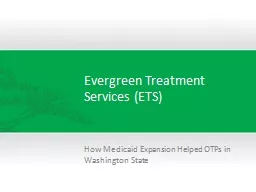PPT-Evergreen Treatment Services (ETS)
Author : debby-jeon | Published Date : 2018-11-01
How Medicaid Expansion Helped OTPs in Washington State Evergreen Treatment Services who we are ETS is a private nonprofit that provides medication assisted treatment
Presentation Embed Code
Download Presentation
Download Presentation The PPT/PDF document "Evergreen Treatment Services (ETS)" is the property of its rightful owner. Permission is granted to download and print the materials on this website for personal, non-commercial use only, and to display it on your personal computer provided you do not modify the materials and that you retain all copyright notices contained in the materials. By downloading content from our website, you accept the terms of this agreement.
Evergreen Treatment Services (ETS): Transcript
Download Rules Of Document
"Evergreen Treatment Services (ETS)"The content belongs to its owner. You may download and print it for personal use, without modification, and keep all copyright notices. By downloading, you agree to these terms.
Related Documents














